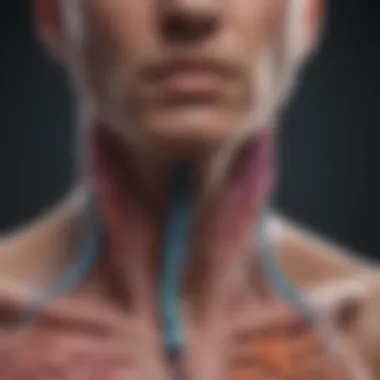CF Mutations: Insights and Clinical Implications


Intro
Cystic fibrosis (CF) represents a complex genetic disorder that impacts various bodily systems, primarily the lungs and digestive system. The understanding of CF has evolved significantly, particularly regarding the mutations in the CFTR gene, which are fundamental to the pathophysiology of this condition. This comprehensive overview aims to shed light on the various CF mutations, their clinical implications, and advancements in treatment strategies.
CF results from mutations in the CFTR gene, responsible for producing a protein that regulates the movement of chloride ions across epithelial cells. When this gene mutates, it affects the CFTR protein, leading to severe consequences for fluid balance in tissues and subsequent complications in organ systems. The implications of these mutations are essential to recognize, as they can influence both the severity of CF and the effectiveness of treatment options available today.
Understanding Cystic Fibrosis
Understanding cystic fibrosis (CF) is pivotal in grasping the complexities of this genetic disorder. CF primarily influences the respiratory and digestive systems, leading to various health challenges. By focusing on this condition, we can discuss how CFTR mutations affect clinical outcomes, treatment, and daily living for affected individuals. This knowledge is essential not only for healthcare providers but also for patients and families navigating the realities of CF.
Definition of Cystic Fibrosis
Cystic fibrosis is a hereditary disorder caused by mutations in the cystic fibrosis transmembrane conductance regulator (CFTR) gene. This gene produces a protein that regulates salt and water transport in epithelial cells. When the CFTR gene is defective, it leads to thick, sticky mucus buildup in various organs, particularly the lungs and pancreas. This accumulation hinders normal function and creates a breeding ground for infections.
The definition can be simplified to emphasize that CF is a condition primarily affecting how the body handles mucus. This defect contributes to chronic respiratory issues and nutritional problems due to digestive difficulties. A widely recognized feature is the excessive salt content in sweat, which can be a key diagnostic indicator for the disease.
Prevalence and Population Impact
Cystic fibrosis is one of the most common genetic disorders among Caucasians, affecting approximately 1 in 3,500 live births in these populations. However, its prevalence varies across different ethnic groups. For instance, the incidence is significantly lower in African and Asian populations.
The impact of CF extends beyond the individual patient; it affects families, healthcare systems, and society at large. Treatments for CF can be expensive and often require lifelong management, emphasizing the need for awareness and research. The disease's implications are not just medical; they also encompass social and psychological challenges for both patients and their caregivers.
Overall, understanding cystic fibrosis requires recognizing its genetic basis, its prevalence across populations, and its substantial impact on quality of life. This foundational knowledge serves as a springboard for exploring the various types of mutations and their clinical implications.
Genetic Basis of Cystic Fibrosis
Understanding the genetic basis of cystic fibrosis (CF) is crucial for comprehending the disease itself. The underlying genetics have implications for diagnosis, treatment, and even patient prognosis. By dissecting the CFTR gene and its mutations, we can begin to understand how these changes lead to the varied manifestations of CF.
CFTR Gene Structure and Function
The Cystic Fibrosis Transmembrane Conductance Regulator (CFTR) gene is located on chromosome 7. It encodes a protein that functions as a channel for chloride ions across epithelial cell membranes. This ion transport is vital for maintaining the fluid balance in tissues, especially in the lungs and digestive system. When CFTR is functioning normally, chloride ions are moved outside the cells, aiding in the production of thin, secretory mucus. However, mutations in the CFTR gene can impair this function, leading to the characteristic thick and sticky mucus found in CF patients.
The CFTR protein structure is composed of five distinct domains. Specifically, there are two membrane-spanning domains and two nucleotide-binding domains, along with a regulatory domain. Each part of the CFTR protein plays a role in its function. Mutations can affect any of these areas, leading to a dysfunctional protein.
The significance of understanding CFTR structure and function lies in its direct relation to targeted therapies. For instance, specific CFTR modulators may improve the function of the altered protein depending on the mutation type. Recognizing these variations can lead to more personalized treatment approaches.
Mechanisms of Inheritance
Cystic fibrosis follows an autosomal recessive inheritance pattern. This means that a child must inherit two copies of the defective CFTR gene—one from each parent—to develop the disease. Parents who are carriers of a single defective gene may not show symptoms but can pass on the mutation. Consequently, genetic testing is essential for determining carrier status, especially in populations at higher risk.
The implications of this inheritance pattern extend into family planning and genetic counseling. Couples may seek guidance on the likelihood of having a child with CF if they are both carriers. The identification of carrier status can also lead to prenatal genetic testing options, allowing prospective parents to make informed choices.
"Understanding the genetic basis of CF not only informs treatment but also opens doors for patients and families regarding genetic counseling and future family planning."
Knowledge about CFTR gene mutations has practical implications for public health as well. Screening programs can help identify carriers and monitor populations more effectively, thereby reducing the incidence of CF.
In summary, the genetic basis of cystic fibrosis encompasses the structure and role of the CFTR gene, modes of inheritance, and the broader implications of these genetic factors. This understanding is instrumental in shaping diagnostic measures and therapeutic strategies, ultimately improving outcomes for those affected by the disease.
Classification of CF Mutations


The classification of cystic fibrosis (CF) mutations is fundamental to understanding the diverse phenotypes and clinical outcomes of the disease. By categorizing mutations into different classes, healthcare professionals can tailor their approaches to diagnosis, treatment, and management. Each classification highlights specific defects and provides insight into how these genetic variations impact the CFTR protein functionality and, consequently, the severity of symptoms in patients.
Understanding these classifications enables researchers and clinicians to predict disease progression more accurately. It also aids in developing targeted therapies, thus improving patient outcomes. Moreover, this classification system is crucial in genetic counseling, helping patients and families comprehend their risks and the implications of CF mutations.
Classifications of Mutations
Cystic fibrosis mutations are primarily grouped into six classes based on the nature of the defect they cause in the CFTR protein. Each class has unique characteristics:
- Class I: No protein is produced due to a synthesis defect.
- Class II: The protein is synthesized but improperly folded, leading to its degradation.
- Class III: Mutations lead to malfunctioning regulation, affecting the protein's gating function.
- Class IV: Here, the protein reaches the cell membrane, but its conductance is reduced.
- Class V: Sufficient protein is produced, but in lower quantity than needed.
- Class VI: Proteins are produced and reach the membrane, but they are unstable and degrade prematurely.
Class Mutations: Protein Synthesis Defects
Class I mutations result in the complete absence of functional CFTR protein. This class is caused by mutations that prevent the synthesis process from commencing. A well-known example is the G542X mutation, which introduces a premature stop codon. Patients with Class I mutations tend to have a severe form of cystic fibrosis, as the lack of CFTR protein disrupts chloride transport significantly. Without effective treatment options, individuals may present with respiratory and digestive issues early in life.
Class Mutations: Processing Defects
Processing defects are characteristic of Class II mutations. These mutations occur when CFTR protein is synthesized but fails to achieve proper folding and maturation within the endoplasmic reticulum. The most common mutation in this class is the F508del mutation, which causes a misfolded protein that is quickly recognized and targeted for degradation. As a result, while some CFTR protein is produced, it is non-functional. This class is also associated with varying clinical severity, although most individuals face significant health challenges.
Class Mutations: Gating Defects
In Class III mutations, the CFTR protein is produced and properly localized to the cell membrane; however, it is unable to open correctly in response to stimuli. These gating defects block chloride ions from passing through the channel as they should. An example is the G551D mutation. Patients may experience milder respiratory symptoms compared to Class I and II, but active management strategies are still necessary to prevent complications.
Class Mutations: Conductance Defects
Class IV mutations allow for some CFTR protein functionality, but the chloride conductance is reduced compared to normal levels. These mutations may result in partial symptom expression, and individuals may have a milder form of the disease. The R117H mutation is a noted example that demonstrates varying severity. Individuals with conductance defects often require continuous treatment to manage respiratory symptoms, although their clinical picture may not be as severe as that of those with higher-class mutations.
Class Mutations: Reduced Quantity
In Class V mutations, sufficient quantities of CFTR protein may be produced, but the amount is below what is necessary for normal function. The splicing mutation IVS8-5T can lead to this situation. Patients with these mutations may show a diverse spectrum of symptoms, often falling between mild and moderate severity. Management needs vary, emphasizing the importance of individualized treatment plans tailored to patient-specific needs.
Class Mutations: Decreased Stability
Class VI mutations refer to those CFTR proteins that are produced and placed at the cell membrane, yet they have reduced stability. They tend to degrade more quickly than normal. An example may include the mutation called S1251N. Patients with these types of mutations could experience progressive symptoms over time due to the instability of CFTR at the cell surface. Ongoing research is vital to find therapeutic approaches that can enhance protein stability.
Understanding the various classes of CF mutations is key to advancing treatment conditiions and improving patient care.
Recognizing these classifications aids in enhancing the understanding of cystic fibrosis, allowing for progress in both research and therapeutic interventions.
Clinical Implications of CF Mutations
The examination of clinical implications connected to cystic fibrosis (CF) mutations is critical. Understanding how these mutations affect patient health can guide treatment plans and improve outcomes. Many factors come into play when discussing clinical implications, including the genotype-phenotype relationship and the associated symptoms.
Correlation Between Genotype and Phenotype
The correlation between genotype and phenotype in cystic fibrosis is complex. Each mutation in the CFTR gene does not necessarily lead to the same clinical features. The genotype, referring to the genetic constitution, provides essential clues about the possible phenotype, which is the observable characteristics. Some mutations, such as those belonging to Class I, typically result in more severe manifestations of CF, while other mutations may lead to milder phenotypes.
Research indicates that the specific variant a patient carries can affect lung function, pancreatic status, and even overall quality of life. Therefore, identifying the mutation type can help healthcare providers tailor treatments more effectively. This correlation may also guide prognosis and management decisions. Understanding these relationships helps in developing personalized approaches to treatment.
Common Symptoms Associated with CF


Cystic fibrosis presents a range of symptoms that vary in severity between individuals. The most common symptoms include:
- Chronic cough: Frequent coughing due to mucus buildup in the lungs.
- Respiratory infections: Increased susceptibility to lung infections, leading to exacerbated pulmonary function.
- Digestive issues: Difficulty in digesting food due to insufficient pancreatic enzyme production.
- Salty sweat: High levels of salt in sweat can be a telltale sign of CF.
- Poor growth: Nutritional challenges can affect growth and development, particularly in children.
It's important to acknowledge that while some patients may exhibit several symptoms, others may have minimal manifestations despite carrying severe mutations. Thus, the clinical implications of CF mutations extend beyond just treatment; they also encompass monitoring and management tailored to individual needs.
Understanding these symptoms and their relationship to specific genetic mutations allows for a proactive approach in care. Early intervention and ongoing management can markedly enhance the quality of life for individuals with cystic fibrosis.
"Every patient is unique; thus, personalized medicine plays a crucial role in managing cystic fibrosis."
Diagnostic Approaches
The diagnostic approaches for cystic fibrosis mutations are vital for accurate identification and effective management of the disease. Early detection can significantly improve the quality of life for patients. When clinicians can pinpoint the specific mutations present, they can tailor treatments more effectively. This also aids in genetic counseling for patients and their families, providing important information about potential outcomes and reproductive options.
Genetic Testing for CF Mutations
Genetic testing plays a crucial role in diagnosing cystic fibrosis. The CFTR gene, which is responsible for cystic fibrosis, can contain hundreds of different mutations. Identifying these mutations helps to confirm a diagnosis in symptomatic patients or identify carriers among asymptomatic individuals.
Benefits of Genetic Testing:
- Early Diagnosis: With newborn screening and genetic testing, clinicians can detect cystic fibrosis before symptoms appear, allowing for early intervention.
- Targeted Treatment: Some therapies are designed for specific mutations, making genetic testing essential for personalized medicine.
- Family Planning: Knowing whether an individual is a carrier of CF mutations informs reproductive choices.
Testing typically involves a simple blood sample or saliva test that can be conducted in a clinical setting. The challenge lies in the sheer variety of mutations. Not all mutations lead to illness, and clinical outcomes can vary significantly based on the type of CFTR mutation. As a result, it is critical to have genetic counseling in conjunction with testing to explain what the results mean for the individual and their family.
Sweat Test Procedures
The sweat test is another authoritative diagnostic approach for cystic fibrosis. It measures the concentration of chloride in sweat. Elevated chloride levels indicate a defect in CFTR function, pointing towards cystic fibrosis as a likely diagnosis.
Key Points About the Sweat Test:
- Non-Invasive: The procedure involves applying a small electrical current to the skin, inducing sweating. This method is generally safe and well-tolerated.
- Reliability: It is widely accepted as the gold standard for diagnosing cystic fibrosis. Results can often be obtained within a few hours.
Considerations:
- Timing: It is recommended to conduct the test when the patient is well, as certain illnesses can affect sweat chloride levels.
- Age Limitations: The test is most accurate in children aged above two months.
Proper diagnostic approaches not only confirm cystic fibrosis but also guide treatment decisions and lifestyle management for those affected.
In summary, diagnostic techniques, including genetic testing and sweat test procedures, are indispensable tools in the fight against cystic fibrosis. They provide crucial insights that inform treatment strategies and contribute to the broader understanding of the interplay between genotype and phenotype.
Current Treatment Strategies
The treatment strategies for cystic fibrosis (CF) have evolved significantly over the years, reflecting advances in our understanding of genetic mutations and their implications. For patients, these strategies are crucial in managing symptoms, improving quality of life, and extending longevity. As the methods of treatment are diverse and multifaceted, they address different aspects of the disease.
CFTR Modulators: Mechanisms of Action
CFTR modulators represent a significant advancement in CF treatment. These drugs target the underlying cause of the condition, focusing on the defective cystic fibrosis transmembrane conductance regulator (CFTR) protein. Three main classes of modulators exist: potentiators, correctors, and amplifiers.
- Potentiators enhance the function of the CFTR protein at the cell surface. For instance, Ivacaftor is a well-known potentiator. It accelerates the opening of the ion channel, which aids in chloride transport across the cell membrane.
- Correctors help move the CFTR protein to the cell surface, which is essential for its functionality. Lumacaftor and Tezacaftor are examples that improve the processing and trafficking of misfolded proteins.
- Amplifiers boost the quantity of CFTR protein on the cell surface without directly modifying its function.


By targeting the specific cystic fibrosis mutations, these modulators can lead to improved lung function and reduced pulmonary exacerbations. Future research continues to focus on new compounds that enhance CFTR activity across a broader range of mutations.
Combination Therapies and Their Efficacy
Combination therapies have emerged as a preferred approach in managing CF. These strategies combine various drugs, which can have synergistic effects, enhancing overall treatment efficacy. For example, combining a potentiator like Ivacaftor with a corrector like Lumacaftor may yield better results than using either agent alone.
- Improved lung function: Patients report measurable improvements in lung function indices, such as forced expiratory volume.
- Reduced frequency of flare-ups: A combination approach has been shown to reduce the number of pulmonary exacerbations, allowing patients to maintain better health.
- Quality of life enhancement: Patients experience overall improvement in their daily activities and general well-being due to these multifaceted treatments.
Notably, clinical trials are essential in evaluating the effectiveness of combination therapies. The results contribute significantly to the development of tailored treatment plans that cater to individual patient needs.
Symptomatic Management of CF
Symptomatic management forms a critical component of treatment strategies for CF. While correcting the underlying defect is crucial, managing symptoms plays an equally important role. This holistic approach is vital in addressing the various challenges faced by CF patients.
- Airway clearance techniques: Devices like inhalation and oscillating positive expiratory pressure devices help remove mucus from the lungs, which can lead to better breathing and decreased infection risk.
- Nutritional support: Given the malabsorption issues frequent in CF, patients need individualized dietary plans rich in fats, proteins, and essential vitamins. Enzymes such as pancrelipase are often prescribed to assist digestion.
- Antibiotics and anti-inflammatories: These medications help control lung infections and reduce inflammation, which is a common complication of CF.
- Regular monitoring: Routine pulmonary function tests and bacterial cultures guide treatment adjustments, ensuring timely interventions for any emerging complications.
In summary, understanding current treatment strategies for cystic fibrosis underscores the necessity of a personalized approach that incorporates novel pharmacological therapies alongside traditional symptom management. Such comprehensive care is vital in achieving optimal outcomes for patients and remains a focal point for future research and clinical practice.
Future Directions in CF Research
Cystic fibrosis (CF) research is at a pivotal juncture, with rapid advancements ushering in new hopes for improved treatment options. This section will delve into key areas of focus for future research. Understanding these directions is critical for researchers, healthcare providers, and patients alike, as it shapes the possibilities for managing CF more effectively. The implications of these studies extend beyond individual therapies and touch on broader health policies, patient care strategies, and ethical considerations in genetic research.
Emerging Therapies and Clinical Trials
Research in cystic fibrosis is emphasizing the development of innovative therapies. Recently, the approval of CFTR modulators, such as ivacaftor, has transformed the treatment landscape. However, a pressing need remains for therapies that can address the specific mutations beyond those currently targeted by existing modulators. Ongoing clinical trials are testing novel compounds that aim to enhance the CFTR protein function in a broader array of genetic contexts.
Moreover, combination therapies are being explored. This approach involves using multiple drugs that can complement each other's action. For instance, combining a CFTR corrector with a potentiator could motivate stronger therapeutic outcomes. The need for clinical trials to assess these combination therapies is paramount. Patient participation in these trials is crucial. It helps developers refine their drugs based on real-world effectiveness and side effects. By participating, patients contribute directly to research and potentially benefit from cutting-edge treatments.
In addition, some trials are looking at non-CFTR pathways. Consideration of alternative targets, such as inflammation reduction and infection control in the lungs, provides another layer of treatment strategies. Approaches might include anti-inflammatory drugs or antibiotics that target specific pathogens prevalent in CF patients.
The Role of Gene Editing Technologies
Gene editing technologies, especially CRISPR/Cas9, have revolutionized many fields of genetics and open new possibilities for treating cystic fibrosis. These technologies allow for precise edits to the genome that could correct the underlying causes of CF. For example, editing the CFTR gene to correct specific mutations could offer a permanent treatment solution rather than managing symptoms.
However, the application of these techniques in humans comes with its own set of challenges. Safety concerns regarding off-target effects need rigorous assessment before any clinical implementation. Ethical considerations also arise, particularly regarding germline editing, which could have implications for future generations.
The future of CF research lies significantly within the potential of gene editing to offer transformative therapies. Collaboration among researchers, ethicists, and regulatory bodies is necessary to ensure that these technologies are developed responsibly. By addressing concerns and advancing knowledge, gene editing could bring us closer to eradicating CF mutations at their source.
"Emerging therapies and gene editing technologies could redefine the management of cystic fibrosis, demanding a multifaceted approach to research and treatment strategies."
Finale
The conclusion of this article serves as an important reflection on the comprehensive exploration of cystic fibrosis (CF) mutations. In examining the wide array of mutations in the CFTR gene, we highlighted their implications for patients, treatment approaches, and ongoing research efforts. It is essential to understand that CF is not just a single condition; rather, it is a collection of genetic variations that lead to diverse clinical outcomes.
By summarizing key findings, we can appreciate how different CF mutations influence the CFTR protein's function, ultimately shaping the clinical features of cystic fibrosis. The insights provided here contribute to a more nuanced understanding of the disease, emphasizing the necessity for personalized treatment options tailored to each patient's genetic profile.
Particularly, the relationship between genotype and phenotype cannot be overstated. As scientists uncover more about specific mutations, they can refine therapeutic strategies, leading to improved patient outcomes. These advances in treatment highlight the relevance of genetic testing and potential future therapies, such as gene editing technologies, which may revolutionize how we address CF at its core.
"Understanding cystic fibrosis at a molecular level opens avenues for more targeted and effective interventions."
Summary of Key Insights
Throughout this article, we touched upon several key insights:
- Genetic Variability: Cystic fibrosis showcases a spectrum of genetic mutations, leading to different presentations and severity of the disease.
- Classification and Implications: Understanding the classes of CFTR mutations allows for targeted approaches in both diagnostics and treatment.
- Link Between Genotype and Phenotype: The relationship between specific mutations and clinical manifestations is essential for personalized medicine.
- Advancements in Research: Continuous progress in genetic testing and experimental treatments illustrates the dynamic nature of CF research, making it a field of urgent significance.
- Future Directions: Innovations in gene therapy hint at potential breakthroughs in curing or significantly altering the course of cystic fibrosis.
By synthesizing this information, we underscore the complexities and ongoing evolution of understanding cystic fibrosis and its mutations, fostering a well-informed community ready to tackle these challenges.















